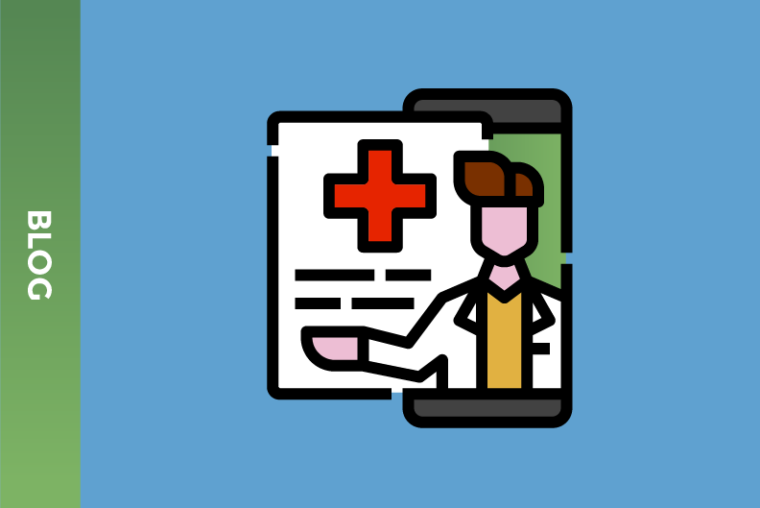What to Know Before Developing a Telemedicine Software

Telehealth is at the top right now and the opportunities for growth are enormous. With the COVID-19 outbreak, remote healthcare services became the main tool of medicine. 93% of healthcare organizations are currently in the process of developing and implementing their digital solutions or have already done that. The purpose is to overcome COVID consequences around the world. How to implement this progressive service? The algorithm contains three main stages:
- Determination of telehealth services you want to provide;
- Development and planning;
- Implementation and monitoring.
In this way before answering the question from the title, we should figure out a number of aspects that affect the cost of the system. First of all, to understand how this system should look at a high level.
In this article, we will talk about the step-by-step process of telehealth platform development and implementation. It will include preliminary market research, legislation, and regulations, business and software development aspects. Let’s begin.
Step 1: Explore the solution market

Many countries have already integrated information technologies into the work of medical institutions. What is the key goal of this initiative? Improve the quality of medical services, increase their availability, and reduce costs.
It is estimated that the global telehealth market will decrease from $83.08B in 2020 to $80.53B in 2021 at a CAGR of -3.06%. This is mainly because companies stabilize their production after an enormous load caused by the pandemic. The market should reach the value of $218.5B in 2025 at a CAGR of 28.34%.
To explore the market, answer the following questions:
- Are there ready-made solutions that can solve your challenges?
- Is there any alternative solution?
- Why would your solution be better?
- What’s new in your future solution?
- To what extent is your solution needed right now?
Step 2: Examine laws and regulations

Before you start to build a new telehealth development platform, pay attention to the laws. In the USA, both federal and state organizations track healthcare systems. The Congress is working on the following bills:
- Executive Order on spreading telehealth to all areas;
- The Connect for Health Act;
- Telemental Health Expansion Act;
- Keep Telehealth Options Act.
Besides, each state has its own regulations. The basic requirement for all telemedicine services in the US is to be HIPAA-compliant.
In Europe, no uniform telemedicine regulations are covering all countries. You can start exploring the regulations in the Union from General Data Protection Regulation (GDPR) — it’s a regulation on data protection and privacy in the European Union (EU) and the European Economic Area (EEA).
Step 3: Define the purpose of the solution which is to be implemented

Then, figure out what the purpose of the solution you want to build is.
To provide better healthcare. Telehealth can be a tool to provide services that are quicker, more accessible, and inclusive for different people. Patients in the USA often don’t go to the hospital because they don’t have insurance or because they don’t know exactly what their insurance covers. Within your solution, you have the chance to simplify it for them via introducing payment on-demand. Building for mobile significantly improves availability — not all patients have laptops.
To improve health outcomes. The efficiency of telemedicine for health outcomes is kind of obvious after the pandemic — if it’s implemented and adopted properly: virtual visits are safer than offline appointments. Apart from that, people who have been willing to use telemedicine services but didn’t have much choice are finally getting that choice now. These are people with chronic pain or fatigue, depression or other mental health disorders, people with disabilities, etc. The care shifts from where the doctor is to where the patients are. An opportunity to consult with health practitioners on symptoms returns patients control over their health, raises their awareness, and reduces anxiety.
To lower the costs. Some telemedicine apps have simple revenue models: subscription-based or pay-per-visit, for example. Patients are more willing to use those than to go to the hospital. So when they do, there are fewer ER admissions because patients get scheduled healthcare and don’t wait until their symptoms get too bad. The costs of cancellations and no-shows also drop because patients don’t have to use transport and go anywhere. Using chats, video calls, etc., combined with symptom checkers or wearables, doctors can provide patients with continuous care using fewer resources than if patients have been admitted to the hospital.
Step 4: Define the business model

At the moment, there is no universal telemedicine strategy. You can come up with a customized solution for your target healthcare organization, patient segment, etc.
You can work in the following directions or combine them all:
- Full-fledged service with EMR integrations, schedules, notes, prescriptions, and billing. Such a service helps doctors access patients’ data, organize their work, and bill insurers more efficiently.
- Healthcare platform for patients to upload their data for doctors to track and comment. Within it, both doctors and patients have an easier time accessing patients’ health data. Patients get a chance to get a medical opinion on, for instance, their X-ray scans instantly after receiving them.
- Virtual consultation room with follow-up visits. The core of telehealth, online communication with doctors, allows for more open and approachable care services.
Telehealth can reduce ER visits and no-shows for hospitals and improve communication between patients and doctors, increasing their care and job satisfaction respectively.
Step 5: Find the right technical partner

Once you are clear with the goals of your telehealth startup, it is crucial to find a partner. You may need to select a niche developer, team, or company with specific experience. Telehealth services require deep integration and complicated workflow, so you will need experts to create a platform with all necessary features. Good industry experts will tailor an individual software solution to match your project requirements. Focus on the telehealth vendors that:
- Provide proven data architecture and engineering solutions in the cloud;
- Provide integration with Electronic Health Records and other systems;
- Comply with HIPAA, GDPR, and other requirements and local medical regulations;
- Provide after development technical support to your platform;
- Offers a high level of data protection and data governance.
Step 6: Implementation

There are several stages required to launch your project:
Business Analysis. Figure out what issues your telemedicine app will solve on the business level and consumer-facing level. It will bring virtual care on board. But how will it affect hospitals or clinics’ operations? Or maybe, if you aren’t working with hospitals, how would doctors find your platform to use it to promote their telemedicine services? Of, if you’re connecting doctors to patients — what needs both of them have in terms of interface, communication within the app, etc.
Business analysis is a discipline that aims to answer as many questions that clarify relationships between developers of the product, its buyer, and its stakeholders as possible. Then, you need to draw your assumptions on how customer expectations from the product are aligned with the current situation in the digital health market and within the healthcare vertical.
Discovery phase. At this phase, you take your assumptions about where your telehealth app should be — within the digital health industry and healthcare — and do in-depth market and customer research, with interviews, surveys, and data gathering. Would your telehealth apps support chats or video calls only? Would it be for all doctors — or just for gastroenterologists or primary care physicians? Would it be for all patients — or maybe just for people at risk of breast cancer? It’s better to choose a small niche and combine it with a popular, easily accessible technology — and scale from it.
In the discovery phase, you get to confirm or disprove your assumptions not only about if your product is truly needed but also about your revenue models. Ask how much are people ready to pay to use a telemedicine platform. Figure out insurers in your locations that cover on-demand telemedicine apps. Find out what hospitals have already implemented telehealth apps and ask what their business outcomes are. Have they seen fewer canceled appointments? Has their patients’ satisfaction increased? Are doctors less or more burnt out using the technology they’re using? Here, you’ll get to learn from other mistakes and bin assumptions that people who’ll use the app do not confirm.
Backend and data architecture. At this stage, your software architects and product managers get to design a system that will meet all customer’s business and technical requirements. Here, they’ll think through third-party integrations your solution will need, all basic features and APIs, the expected scale of the system, expected performance capacity, data models and data flows within this system. If you’re integrating with EHRs, that’s where the details of the data exchange process go. Your HIPAA-based security configurations also should go in here.
Proof of concept (PoC) stage. Here, your product team (or development team of a R&D company you’ve hired) creates an advanced version of a prototype; the simplest app that contains the main features of your telemedicine solution. Often, the term minimum viable product is used along with the PoC. However, an MVP is a functional app, and PoC is often just the simplest working system that’s meant for showing to investors, stakeholders, and very early users. That helps to figure out if they like it, if they use and pay for it, if your assumptions have been correct. You’re still using the “outside” part of system architecture logic you’ve laid out in the previous stage here — the back-end of it, along with all integrations, will be brought to life in the demo.
Digital health companies often forget to take into account the accessibility of health apps. Can a user make the font bigger in the app? Are messages relayed in words, not only in color? Is it possible to merge in real-time data from disparate data sources? PoC stage is perfect for you to detect and close these gaps — and build an app, usable for everyone.
Demo. When you’ve applied all the feedback you’ve gathered at the PoC stage and shaken the changes so they’ll arrange smoothly, it’s time for a demo. A demo is often used to mean either presentation of a product and a trial run of it, and it’s better if you do both. You’ll get these several days with your first adopters to conduct preliminary reports on the app’s usability and functionality, to collect their feedback on the run. Usually, the doctors involved in your demo are the same people who were giving you opinions on a proof of concept — but they use the back-end part of the app, meaning — they connect to patients. They can use analytics. They can integrate with EHRs. Collect their feedback, and root your next sprint in it.
Adoption. When you’ve finished several demo rounds, implemented all fixes, and shot the bug you’ve skipped while testing, it’s time for adoption. Ideally, you have to give medical workers or patients understandable, clear documentation on how to use the app and spend some time with them so they’d get it. Often, companies don’t do that, which is why many digital health solutions create bottlenecks instead of removing them. Be different. Make sure you’ve done everything to make the adoption of new software as non-disruptive and smooth as possible. Don’t forget to include cybersecurity training — it is vital for this industry.
Smooth implementation of software depends on how well you can listen to your users. Healthcare institutions are suspicious of digital health even now after on-demand apps proved to be vital. You need to be interested in their pains, in their bottom lines, in their patients. Also, leave the mindset of moving fast and breaking things before you’ll start building a telehealth solution — any health solution. Digital health does not tolerate haste. Haste in healthcare hurts people. Design and build thoughtfully and with security in mind—or get someone else to do it.
Future prospects
Telemedicine is one of the fastest-growing areas of the health business in the world. Analysts estimate that it will grow 18-20% annually over the next five years. There are many successful examples of telehealth platforms that allow patients to interact with doctors in matters of diagnostics, counseling, checking diagnoses and monitoring the patient’s treatment process, connect doctors within the institution or a specific profession, and build supportive communities for patients with similar conditions. With a well-thought-out implementation plan, your telehealth has more chances to succeed.
WANT TO BUILD A HEALTHCARE MVP BASED ON OPEN DATA?
Learn how to take a concept from a business problem to a functioning solution in a very short period.






